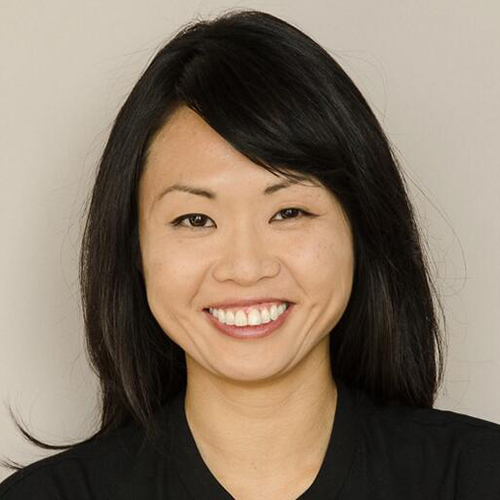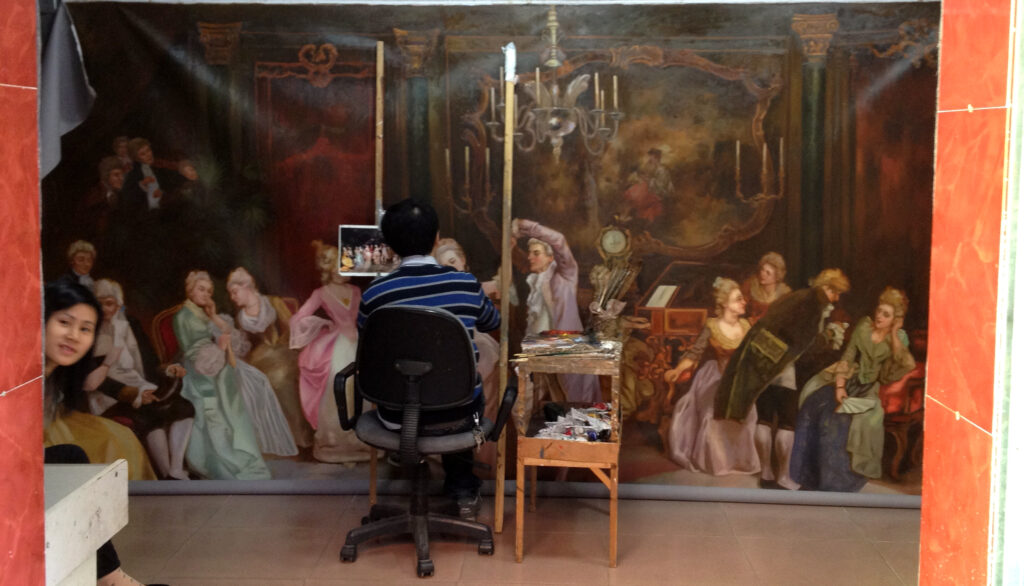When Winnie Wong first saw Dafen Oil Painting Village in 2006, it was nothing like she'd imagined.
Then a graduate student in art history at MIT, Wong had read about the Chinese village in The New York Times. The story described the village as a kind of compound where thousands of artists painted replicas of famous artworks, like da Vinci's "Mona Lisa" or van Gogh's "Starry Night," in mass quantities. These paintings were then exported mostly to Europe and the U.S., where they'd hang on the walls of hotels, restaurants and second-home condominiums.

UC Berkeley
"We had an expectation, which was that there would be this giant factory, and in this factory there would be these painters working in an assembly-line fashion," says Wong, now a professor in the Department of Rhetoric at UC Berkeley. "One person would paint the rocks, one person would paint the trees, one person would paint the sky."
But after she arrived in the village, less than a quarter square mile in size, what she saw over her several years of research surprised her.
No matter how hard she looked, she couldn't find a factory; the biggest assembly line comprised three people. The number of paintings a person could do varied wildly - some could create 25 paintings a day, while others produced one per week. Artists worked in all sorts of spaces, from small studios that sometimes doubled as living quarters to storefront workshops.
Wong is quick to point out that although her research is on the replica painting industry in Dafen in particular, similar operations exist in many other places - in Italy, South Korea, Brazil, even in New Jersey, Los Angeles and other cities in the U.S.
In 2013, Wong published Van Gogh on Demand: China and the Readymade. The book looks at the image of China that many in the West have - that it's a country where mass quantities of cheap things are made with little care - and traces those stereotypes back to their origins in Europe hundreds of years ago. It also talks about the people Wong met in Dafen and how they forever changed the way she thinks about art and authenticity and the nature of creativity.
The many 'Mona Lisas' of Dafen
During her first visit to Dafen, a rural village-turned-production town within the industrial city of Shenzhen near Hong Kong, Wong and two other researchers spoke with a man who was painting in his shop.
Some recognizable works, like the "Mona Lisa" and "Lady with an Ermine" by Leonardo da Vinci, and "The Coronation of Napoleon" by Jacques-Louis David, hung in his store. But most were paintings Wong didn't recognize. Some were replicas of works by lesser-known artists. But there were also original paintings based on photographs of families or their pets. As long as someone ordered it, someone painted it.
After the scholars interviewed the man, Wong recounts, he asked them a few questions in return.
"OK, so the three of you, you've been to a lot of places in the world, right?'" he asked them.
"Well, kind of," they replied.
"OK. Well, what do you think of our village?"
"It's very nice," they said.
And he said, "Well, we think it's very nice here. And we think, for example, that it's nicer than Paris, and we think our Mona Lisas are better. What do you think?"

José Joaquin Figueroa
His question shocked Wong. As an art history student, she hadn't considered that the "Mona Lisa" could exist in the plural, or that one could be better or worse than another - nor that how well a "Mona Lisa" was painted could determine how nice a place was or not.
"It was very, very surprising," she admits. "It really changed my mind."
Wong went on to spend six years in Dafen, researching its artists and its relationship to the global art market. She spent two of those years working as an apprentice artist in a van Gogh studio to better understand the training these artists received. And she interviewed about 200 painters of the estimated 6,000 artists that the government reported worked in the industry.
Wong says the vast majority of painters working in Dafen are considered illicit migrants who come from other, often rural, provinces within China without official registration for urban residency. The painters she met came from a wide range of educational and art backgrounds - some had grown up with intermittent schooling and no exposure to art training at all, while others had a lot of experience, with years of university-level arts education.
And the way they thought about copying another person's art varied widely, too, and often complicated the binary way Westerners tend to think about reproducing a work of art.

Courtesy of Winnie Wong
Wong says that in the West, we tend to think of copying another person's work in two distinct ways: Either it's all bad - a creator's work is their own and should never be copied - or it's all good, in the vein that all copying is transformative, it's how we learn, and imitation is a form of flattery.
But during her time in Dafen, Wong came to realize that there are many other ways of thinking about art replication that occupy a middle ground between good and bad.
Some Dafen painters had what we could call a post-modernist view of the commercialization of art. One painter, who had a background in farming and became a close friend of Wong's, would say his work was "free marketing" for the original artists and that they were "doing what Andy Warhol does." Others came to Dafen to realize their dream of becoming artists, and some were doing it simply because it made money and they didn't mind painting.
"For some of them, it was art," says Wong. "For some of them, it was not."
Since her time in Dafen, Wong has interviewed world-famous artists at the opposite ends of the spectrum and found that they had a lot of similarities with the artists in the oil painting village.
"There is much greater similarity between the most successful artists and the most accused forger than we can imagine," she says, "particularly in the way they think about and relate to the question of: What is art?"
It's a question that Wong and her students explore together at Berkeley.
Fakes, replicas, forgeries - what counts as art?
For the past decade, Wong has taught a course at Berkeley on imitations, appropriations and replicas. In the class, students learn about 12 big forgers throughout history. One is artist Zhang Daqian, who is thought by some to have forged the painting "Riverbank" in the 1950s. While most believe the painting, which is held by the Metropolitan Museum of Art in New York City, was made by the 10th-century master Dong Yuan, skeptics say it's inconsistent stylistically with his other work and therefore can't be the original.
Wong also asks her students to find a scandal to research. Students dive into all sorts of cases in areas like fashion, music, design and social media. There's one case that still puzzles Wong where an Instagram user copied an influencer's life. She posed in the same luxury locations with the same products and even had a look-alike boyfriend.
There is much greater similarity between the most successful artists and the most accused forger than we can imagine.
"This phenomenon of not only reproducing the work of an artist, but a person … that was an interesting scandal," says Wong. "I'm just constantly learning from my students that there is just no shortage of very opposing views about the phenomenon that we generally call 'copying' that take on really complex dimensions."
As artificial intelligence makes dramatic advances, allowing users to harvest other people's art, words and ideas for their own purposes, Wong says her research on fakes and forgeries has reemerged in conversations about what counts as legitimate art.
Americans tend to devalue a product when it's easily available, she says, like it is with AI or replicas of a famous painting. We find a piece of art beautiful or a poem well-written if it's one-of-a-kind and hard to come by. When it's easy to recreate, it disturbs our sense of making and what it means to be creative human beings.
She likens the anxieties that Americans felt about globalization and moving manufacturing to China in the '90s and early 2000s to our current misgivings about AI.
"In the history of forgery, this is a constant kind of aesthetic question, a philosophical question," says Wong. "After you find out something is a forgery, you cannot change it. You somehow cannot undo it in your mind and experience the painting like you did before. In some philosophical thinking, that can seem hypocritical."
It's been a decade since Wong was last in Dafen. In 2015, as part of an interdisciplinary research studio at Berkeley, Wong and architecture and urban design professor Margaret Crawford took a group of graduate students to study urban art villages in the Pearl River Delta region. They spent a day in Dafen, where they visited the van Gogh shop where Wong worked as an apprentice years earlier.

When the group returned to the U.S., students and faculty spent the summer transforming their research materials into a multimedia exhibition of paintings, models, dioramas and video. It was showcased on the Berkeley campus and in Shanghai.
In the years after the 2008 financial crisis in the West, international orders for replica paintings from Dafen dropped, and demand began to shift more toward the domestic market, which grew unabated as the Chinese property market continued to soar until very recently.
"When I saw it in 2015, it was still very active, but it was different," Wong remembers.
With the recent downturn in the property market, Wong suspects that Dafen and its artists are experiencing hard times. She knows the painters are still working, but they face an uncertain future.
After you find out something is a forgery, you cannot … undo it in your mind and experience the painting like you did before. In some philosophical thinking, that can seem hypocritical.
Currently, the mutual hostility between the U.S. and China, as well as censorship by the Chinese government, make the kind of research Wong and her students were able to do just a decade ago nearly impossible.
Wong recalls a time when she was working as an apprentice where she saw firsthand why it's so important that we pay attention to other ways of thinking about art and authenticity.
One day, a group of English-speaking teachers came into the shop, looking for decorations for their new apartment. When they saw "The Starry Night," they couldn't remember why they recognized the image. When Wong told them that it was a replica of the famous painting, they left without buying it.
On the same day, a group of construction workers speaking Mandarin were struck by "Wheatfield with Crows," one of van Gogh's last paintings before he died by suicide.
"These three construction men, dressed in their construction clothing, came in and said, 'van Gogh's last masterpiece: its psychological power.'"
They knew that what they were viewing was a copy of the original painting, but that knowledge didn't prevent them from having a conversation about van Gogh and the painting in front of them.
"At any other given moment, either one of these paintings could have been thought of as a forgery or as an imitation or as an appropriation or as a replica or as any number of things," says Wong.
But perhaps that's not the point, she continues. Maybe bearing witness to these moments, when thoughts about art are made in real time, is actually much more interesting than adhering to certain static ideas about what art is - or isn't.






